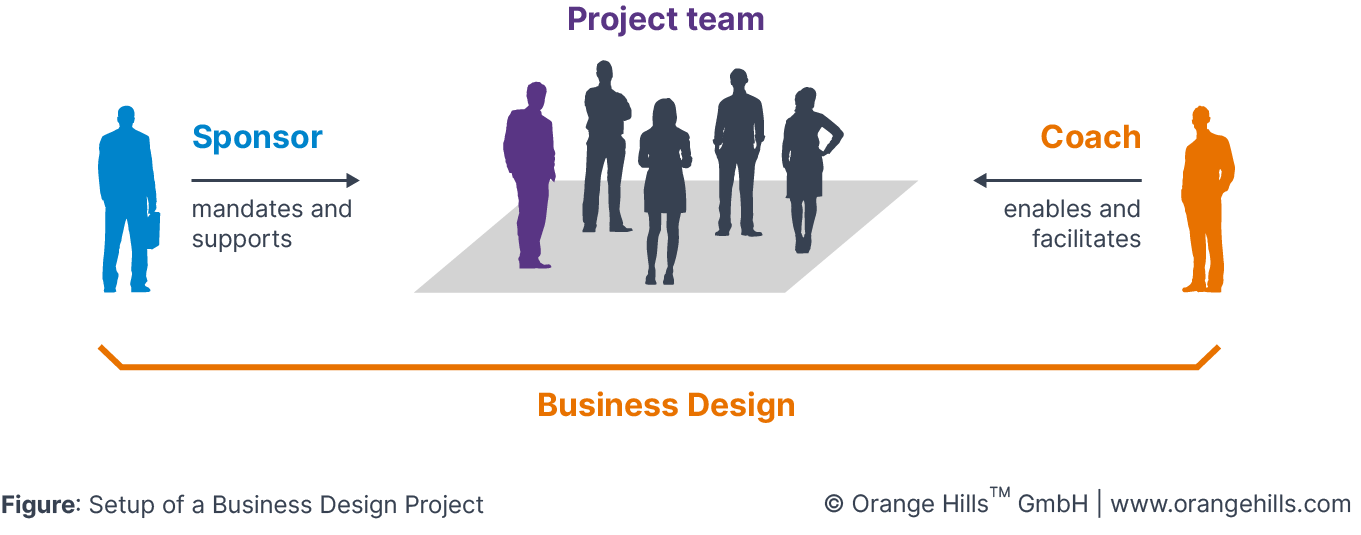Roles in Business Design
This chapter is about the different roles we need to set up a Business Design project and management system properly. We describe skills and responsibilities of each role and go into details about the project team which is critical for success.
Bernhard Doll
Business Design Maverick
The secret recipe of every Business Design project is the effective collaboration of the right people employed in different roles. The Project Team that drives a Business Design project consists of 1x team manager and 2-4x team experts. They work closely with an internal sponsor, who ensures that the results are aligned with the company‘s interest and provides the project team with the required resources. The Business Design coach supports the project team with methodological expertise. Finally, customers play a major role and need to be involved during the whole Business Design process.

A common mistake is to think you need every expert in the Project Team, which results in teams with 7, 8 or even more team members (=never a good idea). If you need experts occasionally treat them as external experts and invite them to workshops whenever you need them.
As a summary, the following roles are key and optional parts of every Business Design project:
The Team Manager leads a project team and is accountable for the results of a Business Design project. He / she is a MacGyver type of person with an overview of all activities involved in the Business Design project driving the project team to high performance. | |
The Team Member is part of the project team and, thus, accountable for the results of a Business Design project. He / she contributes to the success of the project with his / her expertise in engineering, sales, marketing or finance, whilst running through the innovation process. | |
A Business Design Coach is an expert in how to manage and facilitate the Business Design process. He is NOT part of the team but helps each individual and the team as social entity to apply the Business Design approach with its guiding principles, process, roles and tools. | |
Internal Sponsor | ...is highly interested in the results of the Business Design project and, thus, supports the project as a power promoter. He / she signs off budgets, allocates resources, “protects” the team, and intrinsically motivates colleagues to support you. Key activities are:
He /she is accessible for all team members (via direct and fast channels, e.g. SMS, WhatsApp) throughout a Business Design project (NO proxies, PAs and other hierarchical boundaries etc.). |
...is a trained hardware or software engineer who has broad knowledge about prototyping procedures and making things happen under pressure to support validation and testing. | |
Research Expert | ...has a scientific background and his highly experienced in qualitative as well as quantitative research methods to study customers, users and other market players. Key activities are:
|
Customer | ...are very important in every Business Design project. They are not only subjects to study, but are often involved in Business Design activities to build better business models, products and services, which excite them. Key activities are:
|
External Expert | ...are subject-matter experts who have specific knowledge that is needed in certain phases of the Business Design project. They are NOT part of the project team and don't join every workshop. Key activities are:
|
Maverick | ...is a temporary team member usually provided by Orange Hills whose job is to stimulate radical and fresh thoughts within project teams. A "Maverick" is optional but can be very helpful in a Kick-off and Design workshop to make people push their mental boundaries and leave traditional patterns. Key activities are:
|
Portfolio Manager | ...are responsible for managing portfolios of both new ideas as well as innovation projects in various phases of the End-to-End Innovation Process. Key activities are:
|
C-Level Manager / Entrepreneur | ...are the ones who give strategic direction and meaning to everyone and everything that happens in the innovation management system. They are not just passive observers or managers who provide money and resources. C-Level management should be personally and emotionally involved in Business Design. Key activities are:
ps: C-Level Managers can play the role of internal sponsors as well. |
Keep in mind: The biggest mistake you can make as a coach is not paying attention to the team setup! If you get team members who are passionate about the project, trained in Business Design and ready to invest time, you will have a good time with the team and get the team members to 100% performance. In any other case, the project is fated to die right from the start!
